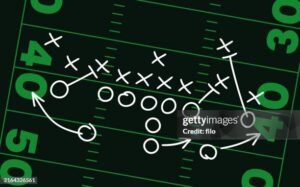Unlocking the NFL Playbook: A Comprehensive Guide to Understanding its Strategies
What is an NFL Playbook?
An NFL playbook serves as a critical tool for teams within the competitive landscape of American football. Essentially, it is a comprehensive compilation of plays and strategies that outlines how a team will operate on the field during games. The significance of the playbook cannot be overstated, as it helps players understand their roles, responsibilities, and the overall game plan devised by the coaching staff. This structured format fosters efficient communication, ensuring that every player is on the same page when executing plays.
A standard NFL playbook includes various components, which can be divided primarily into offensive and defensive segments. The offensive playbook delineates specific plays designed to advance the football, score points, or manage the game clock. It encompasses formations, routes run by receivers, blocking schemes, and the roles of various positions, such as the quarterback, running backs, and offensive linemen. Conversely, the defensive segment focuses on tactics aimed at preventing the opposing team from scoring, detailing strategies such as blitz packages, cover schemes, and alignment responsibilities for defensive players.
Terminology plays a pivotal role in the NFL playbook, with each term crafted to concisely convey complex ideas among players and coaches. Understanding this terminology is essential for athletes, as it allows for precise execution of plays under pressure. Historically, the NFL playbook has seen significant evolution—from simple formations and basic terminology in its early days to the intricate, multifaceted structures observed in today’s game. Modern playbooks incorporate advancements in technology and analytics, making them indispensable for teams aspiring to compete at the highest level.
Key Elements of an NFL Playbook
Understanding the inner workings of an NFL playbook is fundamental for both players and coaches. A well-structured playbook encapsulates various formations and strategies designed to leverage a team’s strengths against an opponent’s weaknesses. Among the most prominent formations are the shotgun, I-formation, and wildcat, each serving a distinct purpose on the field. The shotgun formation, for instance, positions the quarterback several yards behind the center, enabling better vision of the field and quicker release on passing plays. This setup often facilitates a spread attack, allowing for a greater range of receiver options. In contrast, the I-formation is characterized by a fullback and a tailback lined up directly behind the quarterback, promoting a balanced attack that is equally inclined to run or pass, thereby confusing defensive schemes.
Furthermore, the wildcat formation is a more innovative and flexible approach, often involving direct snaps to the running back, which can catch defenses off-guard due to its unpredictability. Each formation in an NFL playbook is tailored to exploit specific defensive alignments, maximizing opportunities for successful plays. However, beyond just the formations, understanding down-and-distance situations is crucial. The playbook is neither static nor uniform; it adapts based on the yardage required to achieve a first down. For example, the type of plays called on a second-and-short scenario will vastly differ from a third-and-long situation, requiring different strategies to capitalize on the opportunities presented.
Moreover, the significance of notable plays should be emphasized, as they often define seasons and develop a team’s identity. Iconic plays such as the “Immaculate Reception” or the “Hail Mary” have not only made history but also influenced how playbooks are written and evolved. The fusion of creative formations and strategic play-calling encapsulates the essence of the NFL playbook, making it a vital tool for understanding professional football.

How Teams Use the NFL Playbook Strategically
The NFL playbook serves as an essential foundation upon which teams build their game strategies. Coaches and players rely on the playbook not only to outline specific plays but also to develop comprehensive game plans tailored to their opponents’ strengths and weaknesses. During the preparation phase leading up to a game, coaching staff meticulously analyze film and study opposing teams in order to identify patterns and tendencies that can be exploited. This strategic analysis is crucial for designing a game plan that maximizes offensive and defensive capabilities.
Throughout the week, teams operate within the framework of the playbook to practice and refine their strategies. They focus on understanding the intricacies of each play and how they may need to adapt them based on the opponent’s defensive or offensive setups. The playbook also includes contingencies for various in-game situations, ensuring players are prepared to adjust their tactics accordingly during critical moments. This adaptability becomes vital, as real-time adjustments can determine the outcome of the game.
Communication is another key element in leveraging the NFL playbook effectively. Coaches often utilize a combination of verbal instructions, hand signals, and digital technology to relay plays to players, ensuring clarity in high-pressure scenarios. The integration of modern technology enhances playbook management, allowing for more efficient updates and easier access for players. Many teams now utilize tablets or apps that contain interactive versions of the playbook, which enhances players’ understanding and allows for ongoing learning.
Ultimately, the strategic use of the NFL playbook is vital for a team’s performance on the field. It is a collaborative effort that requires thorough preparation, real-time decision-making, and clear communication, enabling teams to compete at the highest levels of professional football.
The Future of the NFL Playbook: Trends and Innovations
The NFL playbook is continuously evolving, shaped by various factors that include advancements in technology, changes in player skillsets, and the influence of data analytics. As teams seek competitive advantages, new strategies and innovations are emerging, fundamentally altering the landscape of professional football. One significant trend is the increasing reliance on data analytics. Coaches and analysts now utilize complex algorithms to assess player performance and game situations, allowing for more informed decision-making. This integration of analytics into the NFL playbook empowers teams to tailor their plays to specific opponents, enhancing their chances of success on the field.
nfl playbook Moreover, wearable technology is also playing a crucial role in the evolution of play designs. By equipping players with devices that track movement and physiological responses, teams can gather valuable insights into player stamina, speed, and overall health. This data can inform coaching strategies and lead to the creation of more effective plays that align with players’ strengths and weaknesses. Consequently, we can expect to see a shift toward more dynamic passing plays, incorporating varying routes and timings that exploit defensive weaknesses.
Additionally, the concept of run-pass options (RPOs) has gained considerable traction in recent years. These plays allow quarterbacks to evaluate the defense’s alignment and make split-second decisions to either hand off the ball or pass it, creating unpredictability and challenging defensive schemes. As the NFL continues to adapt to rule changes aimed at enhancing player safety, we may witness further innovations in how plays are designed in the playbook, prioritizing quick movements and less physical confrontation without sacrificing excitement and robust gameplay. As we look toward the future, the convergence of technology, analytics, and player capabilities will undoubtedly influence the NFL playbook, leading to even more sophisticated strategies and innovative gameplay.

